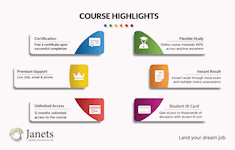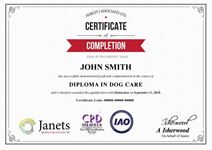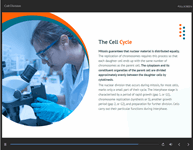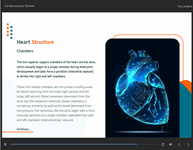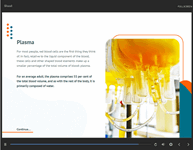Anatomy and Physiology of Human Body
FREE PDF Certificate | Audio Visual Training | 10 CPD Points | Tutor Support | 1 Year Access
Janets
Summary
- Tutor is available to students
Add to basket or enquire
Overview
The human body is a mystery itself. To give learning enthusiasts and existing practitioners a better understanding of the human body, we have prepared this course with the knowledge and guidance of our instructors.
Every fundamental concept of the human body is discussed in this course thoroughly to ensure the best learning output from the learners that will enrol in this course. Therefore, the fundamental concepts are described at the beginning of this course, and the course gradually approaches more complex topics. This method keeps our learners engaged in the course and helps them to learn and understand the topic. Every possible aspect of the human body is described in this course, providing a detailed overview of human anatomy and physiology.
If you want to learn exciting facts about the human body deeply and want to understand how things work, get yourself enrolled in this course.
So, are you ready to start your journey to explore and enhance your knowledge of Anatomy and Physiology?
Learning Outcome
After completing this course, learners will gain knowledge of-
- The structural units of the Human body
- Cells type and function
- Various physical Processes
- Tissues and their working principle
- Systems controlling the human body
- Blood and digestive systems
- Structure and reproductivity of human
What You Get Out Of Studying With Janets
- Free PDF certificate upon successful completion of the course
- Full one-year access to course materials
- Instant assessment results
- Full tutor support available from Monday to Friday
- Study the course at your own pace
- Accessible, informative modules taught by expert instructors
- Get 24/7 help or advice from our email and live chat teams with the training
- Study at your own time through your computer, tablet or mobile device
- Improve your chance of gaining valuable skills by completing the course
✦✦✦ Enrol in the Anatomy and Physiology of Human Body course to find out more about the topic and get one step closer to reaching your desired success ✦✦✦
CPD
Course media
Description
The course is delivered through Janets’ online learning platform. The Anatomy and Physiology of Human Body has no formal teaching deadlines, meaning you are free to complete the course at your own pace.
Course Modules
Module 1: The Chemistry of Cells
- The Most Important Elements
- Subatomic Particles
- Periodic Table of Elements
- Chemical Bonds
- pH: Ions, Acids, and Bases
- Organic Compounds: Carbohydrates and Proteins Carbohydrates
- Organic Compounds: Lipids and Nucleic Acids
Module 2: Cells
- Plasma Membrane
- Movement Across-Cell Membrane
- Active Movements Across Membranes
- Cytoplasm
- Cell inclusion
Module 3: Cell Division
- The Cell Cycle
- Chromosome Structure
- Interphase
- The Stages of Mitosis
- A Cell Clock
Module 4: Replication and Metabolism
- DNA Replication
- Transcription
- Translation
- Enzymes
- Glycolysis
- TCA Cycle
- Electron Transport System
Module 5: Human Tissues
- Tissue Origins and Development
- Epithelial Tissue
- Connective Tissue
- Muscle Tissue
- Nervous Tissue
Module 6: Skin
- Functions of Skin
- Structure of Skin
- Hair and Nails
- Keeping Skin Healthy
Module 7:Human Skeletal System
- Functions of Bones
- Structure of Bones
- Bone Growth
- Skeletal System Joints
- Keeping Bones and Joints Healthy
- Bone Fractures
Module 8: The Muscular System
- Types of Muscle Tissue
- Functions of the Muscular System
- Gross Anatomy of Skeletal Muscles
- Muscles, Bones, and Movement
- Muscle Injuries
Module 9: Skeletal Muscle Fibre
- Microanatomy of Skeletal Muscle Fibre
- Types of Muscle Fibres
- Blood Supply
- Skeletal Muscle Contraction and Relaxation
- Energy Sources for Muscle Contraction
- The Organisation of the Skeletal Muscular System
- Skeletal Muscle Movement
- The Effects of Ageing
Module 10: Nervous System
- The organisation of the nervous system
- Sensory division of the peripheral nervous system
- Central nervous system
- Motor division of the peripheral nervous system
- Neurotransmitters
- Neuroglia
- Cerebrospinal fluid
Module 11: The Brain
- The Anatomical Regions of Brain
- The Peripheral Nervous System
- Cranial Nerves
- The Spinal Cord
- The Autonomic Nervous System
Module 12: Nervous System—Spinal Cord and Spinal Nerves
- Nervous System
- The Spinal Cord
- Spinal Cord Anatomy
- The Reflex Arc
- The Spinal Nerves
- Clinical Application
Module 13: Nervous System - Autonomic Nervous System and Cranial Nerves
- The Autonomic Nervous System
- Somatic Nervous System
- Autonomic Nervous System
- Divisions of the Autonomic Nervous System
- The Sympathetic and Parasympathetic Nervous Systems
- The Cranial Nerves
- Clinical Applications
Module 14: Nervous System—The Eyes
- The Anatomy of the Globe (Eyeball)
- Clinical Application
- Accessory Structures of the Eye
- Physiology of Light and Vision
- Disorders
Module 15: Nervous System—The Ears, Hearing, and Equilibrium
- Anatomy and Physiology of the Organs of Hearing
- Clinical Application
- Anatomy and Physiology of the Organs of Balance (Equilibrium)
- Potential Problems with Hearing and Balance
Module 16: Nervous System—Memory
- Memory areas of the brain
- Types of memory
- Possible causes of memory loss
- Pathology of the brain
- Pathology of the spinal cord
Module 17: Sensory Systems
- Reception and Perception
- Special Senses
- Smell
- Taste
- Vision
- Hearing
- Balance
- General Senses
- Diseases and Disorders
Module 18: Cardiovascular System
- Heart Structure
- Processes of Heart
- Blood Vessels
- Circulation
- Blood Pressure
Module 19: Blood
- Blood
- Plasma
- Red Blood Cells
- Blood Groups
- White Blood Cells
- Platelets
- Hemostasis
Module 20: Lymphatics
- Lymph
- Lymphatic Circulation
- Primary Lymphoid Organs
- Secondary Lymphoid Organs
Module 21: Immune System
- Innate and Natural Immunity
- Adaptive Immunity: Humoral
- Adaptive Immunity: Cellular
Module 22: Digestive System
- Divisions of the Digestive System
- Oral Cavity
- Pharynx
- Esophagus
- Structural Layers of the Alimentary Tube
- Stomach
- Small Intestine
- Liver
- Gallbladder
- Pancreas
- Large Intestine
- Ageing and the Digestive System
Module 23: Respiratory System
- The Upper Respiratory Tract
- The Lower Respiratory Tract
- The Lung Surface
- The Pleura and Pleural Cavity
Module 24: Urinary System
- Kidneys
- Blood Flow
- Renal Pyramids
- Nephrons
- Renal Corpuscle
- Proximal Convoluted Tubule
- Intermediate Loop
- Distal Convoluted Tubule
- Collecting Duct
Module 25: Male Reproductive System
- Testes
- Spermatogenesis
- Extratesticular Reproductive Tract
- Glands of the Male Reproductive Tract
- External Genitalia
- Male Sex Hormones
Module 26: Female Reproductive System
- Ovaries
- Female Reproductive Tract
- External Genitalia
- Female Sex Hormones
- Reproductive Cycle
Method of Assessment
To successfully complete the course, students will have to take an automated multiple-choice exam. This exam will be online and you will need to score 60% or above to pass the course.
After successfully passing the course exam, you will be able to apply for a certificate as proof of your expertise.
Certification
All students who successfully complete the course can instantly download their free e-certificate. You can also purchase a hard copy of the certificate, which will be delivered by post for £9.99.
Who is this course for?
This course will assist you in getting your desired job in the relevant field. The system will also progress your career, regardless of your present job status. This Anatomy and Physiology training is suitable for the following:
- Medical Healthcare Professional
- Biological Researcher
- Medical Science Analyst
- Anatomy specialist
- Physiology student
Requirements
No prior qualifications are needed for Learners to enrol on this course.
Career path
This online course is ideal for anyone looking to start a career in the field, which includes the following related professions:
- Doctor ( £42,071 per annum)
- Research Assistant, Medical (£25,359 per annum)
- Research Associate (£29,724 per annum)
- Registered Nurse (£23,670 per annum)
Questions and answers
Hello is this level 3 in Anatomy and physiology CPD entry
Answer:Hi Carol, Thank you for your interest. Yes, it is a level 3 course with CPD accreditation. Stay Safe.
This was helpful.
Reviews
Currently there are no reviews for this course. Be the first to leave a review.
Legal information
This course is advertised on reed.co.uk by the Course Provider, whose terms and conditions apply. Purchases are made directly from the Course Provider, and as such, content and materials are supplied by the Course Provider directly. Reed is acting as agent and not reseller in relation to this course. Reed's only responsibility is to facilitate your payment for the course. It is your responsibility to review and agree to the Course Provider's terms and conditions and satisfy yourself as to the suitability of the course you intend to purchase. Reed will not have any responsibility for the content of the course and/or associated materials.
